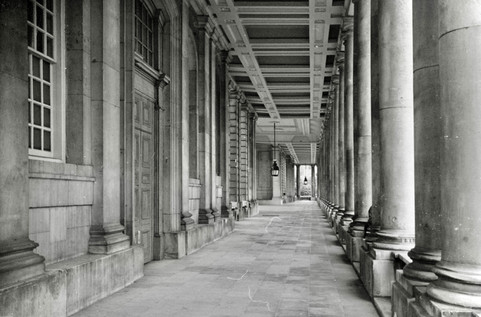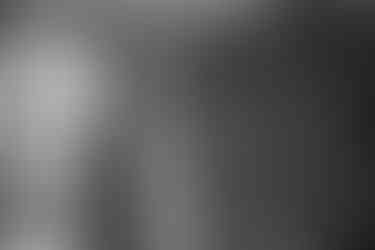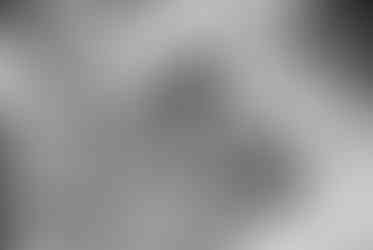The Gift of Architectural Photography on Film
- Michael Elliott

- Aug 23, 2023
- 4 min read
Architecture photography marries two long-standing art forms in a serendipitous blend of light, lines, and profound craftsmanship. It allows us to capture and immortalise the temporal aspects of man-made structures in a world that is continuously evolving. For those yearning to understand this genre and the irreplaceable charm of film photography, this guide will serve as a good jumping off point into the genre.
The Old Royal Naval College, Greenwich - two views: 1) straight along the colonnades towards Canary Wharf, with the Wren designed domes as bookends; 2) through one of the colonnades. Photo credits: Michael Elliott
The Allure of Architecture Photography on Film
Film photography and architectural images form a timeless duet that echoes the nostalgia of the past while embodying the potential of the present. From the structural geometry of Brutalism to the baroque intricacies of Victorian architecture, film photography provides a unique aesthetic that makes these art forms accessible yet mysteriously intriguing.
The grain, tone, and depth rendered by film can enhance architectural forms, amplifying their physicality and emotional impact. This ability to cast a fresh lens on familiar cityscapes or bring to life the latent beauty of forgotten structures is at the core of architecture photography on film.
Thamesmead (Southmere Lake/tower blocks) - two views: 1) from Abbey Wood direction towards Southmere Lake, with low rise blocks ending in the high rise blocks well known from A Clockwork Orange; 2) across the lake in colour, with the Southmere tower blocks standing proud and almost rejuvenated. Photo credits: Michael Elliott
You may wonder, why choose film over digital in our tech-savvy era? Despite the convenience of digital, the tangibility of film, with its capacity to reveal unexpected aspects of a scene, remains unrivalled. The process of developing and scanning your film introduces an element of surprise, further fuelling the artistic pursuit.
Unearthing the Beauty of Brutalism on Film
Brutalist architecture, characterised by its bold, monolithic forms and raw, exposed concrete, has been a subject of contention among the masses. However, when captured on black and white film, the stark, imposing structures adopt an ethereal quality, making Brutalism a favourite among many architectural photographers.

Equipment and Film Types for Architectural Photography
Understanding and selecting the right equipment is crucial in architecture photography. While digital photography allows endless experiments with a simple reset, film photography demands a more calculated approach due to the cost of film and development.
For architectural photography, a 35mm or medium format camera that offers shift movements can help control perspective distortion, a common issue when photographing tall structures. Brands like Nikon, Canon, and Hasselblad offer film cameras that can deliver spectacular results.
The type of film used significantly influences the outcome. Black and white film, such as Ilford Delta 100 or Kodak Tri-X 400, emphasise texture and contrast, ideal for capturing architectural details. For colour photography, Kodak Portra and Fujifilm Provia offer vibrant hues and excellent sharpness, perfect for showcasing architectural marvels in their full glory.
The "falling building" effect can be put to excellent use to emphasise drama and imposition, as this selection of photographs shows. Photo credits: Michael Elliott
Tilt-Shift Lenses: An Architectural Photographer’s Secret Weapon
Tilt-shift lenses allow photographers to control perspective and depth-of-field in ways standard lenses can't, making them an invaluable tool for architectural photography. They help maintain straight lines and avoid the 'falling building' effect, common when photographing tall structures.

Techniques for Capturing Striking Architectural Images on Film
Capturing architectural subjects extends beyond just photographing buildings. It's about encapsulating the essence, history, and the architect's vision. Let's explore techniques that can elevate your architectural images:
Composition: Architectural photography thrives on symmetry, leading lines, and repeating patterns. Experimenting with different angles can also add dynamism to your images (link: "Mastering Composition in Photography: A Comprehensive Guide").
Light: Just like any photographic genre, understanding and manipulating light is key. The soft light of golden hours can render a dreamy effect, while midday sun can bring out intricate shadows adding depth to your architectural subjects.
Details: Focusing on specific elements or details of a structure can yield fascinating abstract images. From the repeating patterns of windows to the intricate designs of a doorway, these shots can tell a story just as powerfully as capturing the entire building.
Architectural photography doesn't need to focus on the whole building; in fact, isolating elements of architecture can be more powerful and impressive than the whole, as this selection of photographs show. Photo credits: Michael Elliott
Developing and Scanning Your Film
After capturing your architectural marvels on film, the next steps are developing and scanning the film. For black and white film, many photographers prefer developing at home. It gives more control over the process and can be quite cost-effective over time.
Scanning your negatives is the final step to bring your images into the digital realm for sharing and printing. Whether you choose a flatbed scanner, a dedicated film scanner, or professional lab scanning will depend on your budget, volume of film, and required scan quality.
Analog vs. Digital: Understanding the Resolution of Film
One might wonder how the resolution of analog film compares to digital images. While it's not an apples-to-apples comparison, it's generally accepted that a well-exposed 35mm film can yield a digital equivalent of 20 to 24 megapixels. Medium and large format films can offer significantly higher resolution, revealing the stunning detail and depth that film photography enthusiasts love.
Post-Processing and Printing Your Architectural Photos
Post-processing is a crucial step in film photography. Software like Adobe Lightroom and Photoshop allow you to fine-tune your scans, adjust contrast, correct colour balance, and sharpen details. However, remember that the aim should be to enhance rather than alter your images drastically.
Printing your photos, be it for a portfolio, exhibition, or personal collection, is the final joy of the photographic journey. Depending on your preference, you can opt for traditional darkroom prints or digital prints from your scans.

As we navigate through the concrete and glass labyrinth of the modern world, architecture photography on film allows us to pause, observe, and appreciate the artistic dialogue between human ingenuity and natural elements. So, load up your camera, step out, and start exploring the architectural wonders around you, one frame at a time.





































Comments